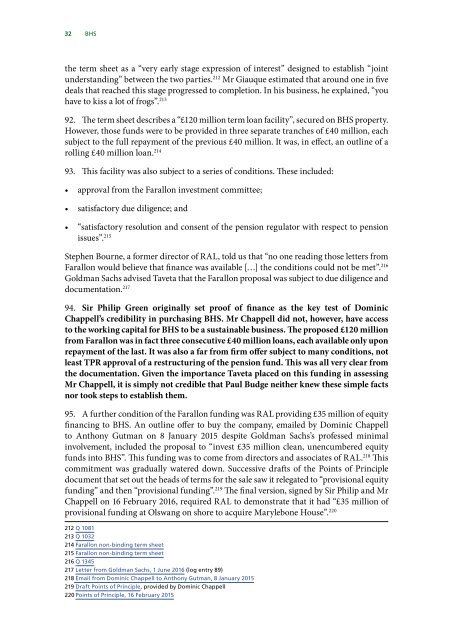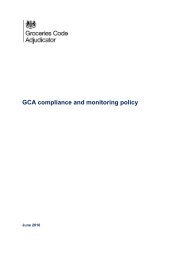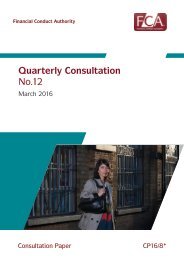Create successful ePaper yourself
Turn your PDF publications into a flip-book with our unique Google optimized e-Paper software.
32 <strong>BHS</strong><br />
the term sheet as a “very early stage expression of interest” designed to establish “joint<br />
understanding” between the two parties. 212 Mr Giauque estimated that around one in five<br />
deals that reached this stage progressed to completion. In his business, he explained, “you<br />
have to kiss a lot of frogs”. 213<br />
92. The term sheet describes a “£120 million term loan facility”, secured on <strong>BHS</strong> property.<br />
However, those funds were to be provided in three separate tranches of £40 million, each<br />
subject to the full repayment of the previous £40 million. It was, in effect, an outline of a<br />
rolling £40 million loan. 214<br />
93. This facility was also subject to a series of conditions. These included:<br />
• approval from the Farallon investment committee;<br />
• satisfactory due diligence; and<br />
• “satisfactory resolution and consent of the pension regulator with respect to pension<br />
issues”. 215<br />
Stephen Bourne, a former director of RAL, told us that “no one reading those letters from<br />
Farallon would believe that finance was available […] the conditions could not be met”. 216<br />
Goldman Sachs advised Taveta that the Farallon proposal was subject to due diligence and<br />
documentation. 217<br />
94. Sir Philip Green originally set proof of finance as the key test of Dominic<br />
Chappell’s credibility in purchasing <strong>BHS</strong>. Mr Chappell did not, however, have access<br />
to the working capital for <strong>BHS</strong> to be a sustainable business. The proposed £120 million<br />
from Farallon was in fact three consecutive £40 million loans, each available only upon<br />
repayment of the last. It was also a far from firm offer subject to many conditions, not<br />
least TPR approval of a restructuring of the pension fund. This was all very clear from<br />
the documentation. Given the importance Taveta placed on this funding in assessing<br />
Mr Chappell, it is simply not credible that Paul Budge neither knew these simple facts<br />
nor took steps to establish them.<br />
95. A further condition of the Farallon funding was RAL providing £35 million of equity<br />
financing to <strong>BHS</strong>. An outline offer to buy the company, emailed by Dominic Chappell<br />
to Anthony Gutman on 8 January 2015 despite Goldman Sachs’s professed minimal<br />
involvement, included the proposal to “invest £35 million clean, unencumbered equity<br />
funds into <strong>BHS</strong>”. This funding was to come from directors and associates of RAL. 218 This<br />
commitment was gradually watered down. Successive drafts of the Points of Principle<br />
document that set out the heads of terms for the sale saw it relegated to “provisional equity<br />
funding” and then “provisional funding”. 219 The final version, signed by Sir Philip and Mr<br />
Chappell on 16 February 2016, required RAL to demonstrate that it had “£35 million of<br />
provisional funding at Olswang on shore to acquire Marylebone House”. 220<br />
212 Q 1081<br />
213 Q 1032<br />
214 Farallon non-binding term sheet<br />
215 Farallon non-binding term sheet<br />
216 Q 1345<br />
217 Letter from Goldman Sachs, 1 June 2016 (log entry 89)<br />
218 Email from Dominic Chappell to Anthony Gutman, 8 January 2015<br />
219 Draft Points of Principle, provided by Dominic Chappell<br />
220 Points of Principle, 16 February 2015






